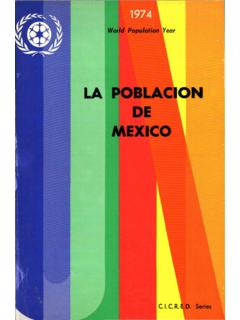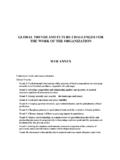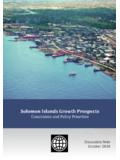Transcription of POPULATION, URBAN DEVELOPMENT AND THE …
1 population , URBAN DEVELOPMENT AND THE environment IN UGANDA: THE CASE OF KAMPALA CITY and its ENVIRONS BY Assoc. Prof. J .B. Nyakaana. Assoc. Prof .H. Sengendo Dr. S. Lwasa Makerere University Faculty of Arts Box 7062 Kampala, Uganda. Email: Abstract Uganda is experiencing rapid urbanization estimated at an annual growth rate of where Kampala has remained a primate city since 1969 growing at annual rate of With this growth rate, Kampala ii absorbs 40% of the national URBAN population and of the national population (UBOS, 2002).
2 Kampala s growth and DEVELOPMENT is characterized by the sprawl into hitherto rural areas engulfing formerly satellite towns within a radius of 32 kilometers. The urbanized area has become metropolitan spanning approximately 386 square kilometers. But, the growth and expansion are associated with lack of infrastructure, social services and pose planning and environment problems. The challenge is how to address the problems through pro-active policy and concerted effort by the city authority, government Civil society and public. This research examined the relationship between population , DEVELOPMENT and environment in Kampala and its immediate environs for policy action that would promote sustainable urbanization and DEVELOPMENT of Kampala metropolitan area.
3 Kampala is selected because of its strategic and functional roles as a commercial, industrial, administrative, social, economic and cultural hub of Uganda. The study combined several research methods that included secondary data from various reports, and policy documents dotted around in different agencies, which have tried to address the environment and DEVELOPMENT issues of the city. Remote sensing techniques and GIS were also utilized to spatially analyze the relationships between population , DEVELOPMENT and environment with a focus on housing, industrial DEVELOPMENT and how they relate to pollution, land cover change, challenges of waste management and sanitation in the metro area of Kampala.
4 From the study findings, it s apparent that Kampala is faced with environmental problems that are putting pressure on the existing infrastructure while the poor settlements are beset with environmental burdens that are deteriorating the well-being of the dwellers. As the environment deteriorates, so is the increase in poverty due to reliance by the URBAN poor on natural resources through URBAN agriculture, natural resource extraction, informal production and trade as coping strategies. To respond to these challenges, some policy recommendations are proposed to break the vicious circle of population , environment and poverty.
5 Introduction to the study Kampala, Uganda s capital city has experienced rapid population growth of annum and a total of income from 774,241 in 1991 to million in 2002 (UBOS 2002). The growth, which has occurred concomitantly with changes in the population structure of the city, is largely influenced by rural- URBAN migration. population increase in Kampala metropolitan area is responsible for increased demand for employment, land for housing, social services and infrastructure that have stimulated spatial URBAN DEVELOPMENT and industrialization.
6 Though the current URBAN DEVELOPMENT can be applauded due to increase in employment opportunities, housing stock, social services and expanding infrastructure, such DEVELOPMENT is occurring in a haphazard manner largely dominated by the URBAN informality in most of the sectors. This has greatly contributed to the unsustainable utilization of natural resources within the metro area resulting in environmental degradation through solid waste accumulation, wetland encroachment and destruction, water pollution and land use/cover change that is reducing the ecological services from the natural environment of the metro area (NEMA 2000/01; Matagi 2001; Walter et al.)
7 2005). The resultant living environment of the URBAN poor in the city is deplorable with poor sanitation, inadequate housing, poorly managed solid and human wastes, increased water pollution and reduction in ecological services. Consequently this has exacerbated vulnerability of Kampala s population and communities to natural disasters. Coping strategies have been devised by the URBAN poor for their adaptation to URBAN economy and environment . As a multi-disciplinary study, the research evaluated the demographic changes in Kampala and their influence on the environment through URBAN DEVELOPMENT focusing on housing, industrialization and economic activities in the metro area.
8 Research Issue and Conceptual Framework Human beings have changed the ecosystems and environment more rapidly and extensively in the 1990s than in any comparable period of time in history. Through socio-economic, political and cultural globalization processes, people are at the center of environmental change at the global level. While local environmental processes are largely driven by demographic characteristics, composition and structure, the study evaluated the impact of the background factors of demographic changes population growth, composition and migration and how they accelerate the urbanization process through URBAN DEVELOPMENT , industrialization, and housing.
9 The research examined the relationship between URBAN population dynamics and URBAN DEVELOPMENT and how the relationship leads to environmental changes though wetland degradation, solid waste accumulation, water pollution, land use/cover changes and housing, existing infrastructure like water supply, sanitation and solid waste disposal in the metro area. The study also analyses how vulnerable groups (low income, women, street traders, children, unemployed) have devised coping strategies further impacting on the environment through informal activities and unplanned housing provisioning.
10 (Fig. 1). Whereas the schematic representations may imply a linear relationship between population dynamics and URBAN DEVELOPMENT , a two-way interaction exists continuously. It is also recognized that there are also other mediating external factors, which are not a focus of the research. This conceptual framework offers a basis for an assessment of the linkages and derivation of policy recommendations for sustainable URBAN DEVELOPMENT in Uganda. Such an assessment is envisaged to make a significant contribution to knowledge about the effects of population dynamics and URBAN DEVELOPMENT on the environment .







